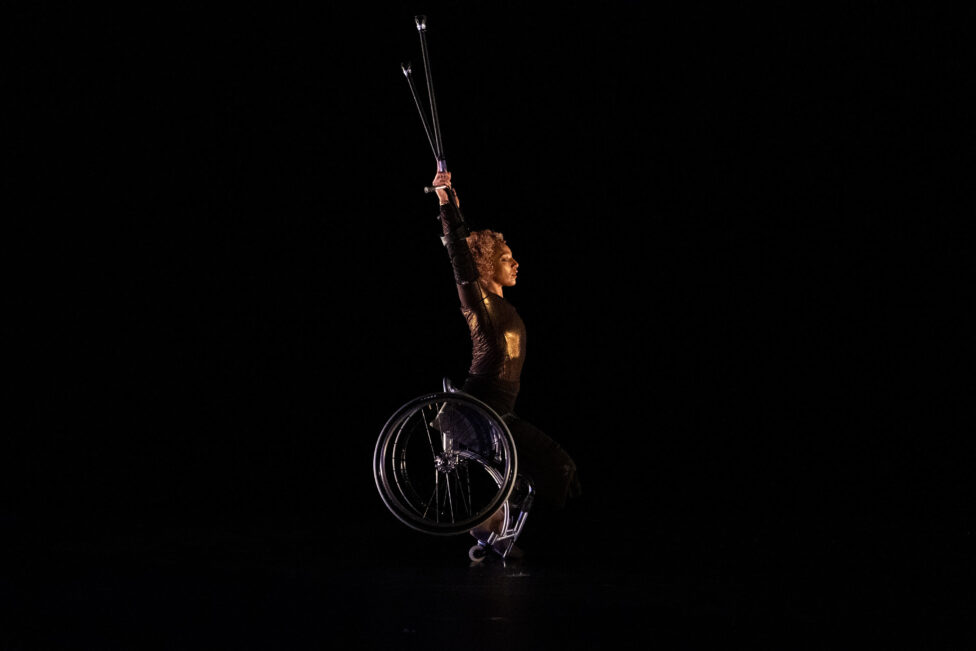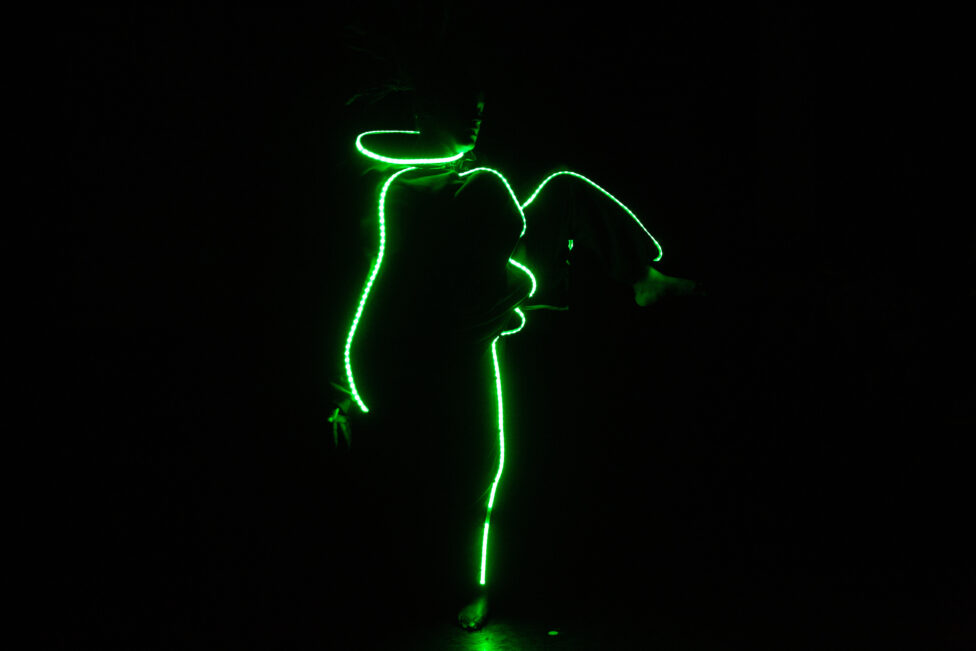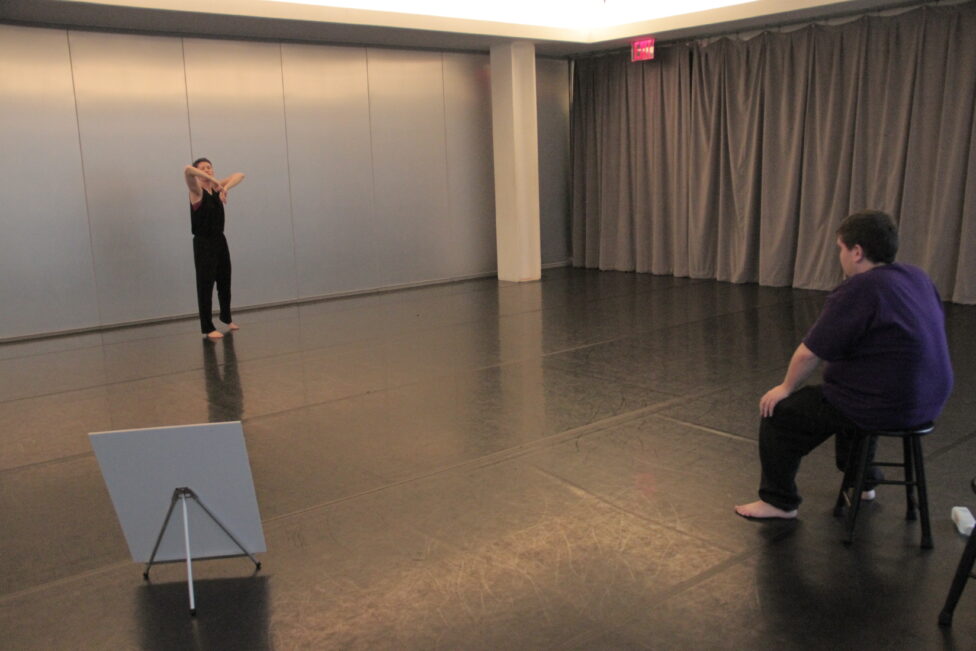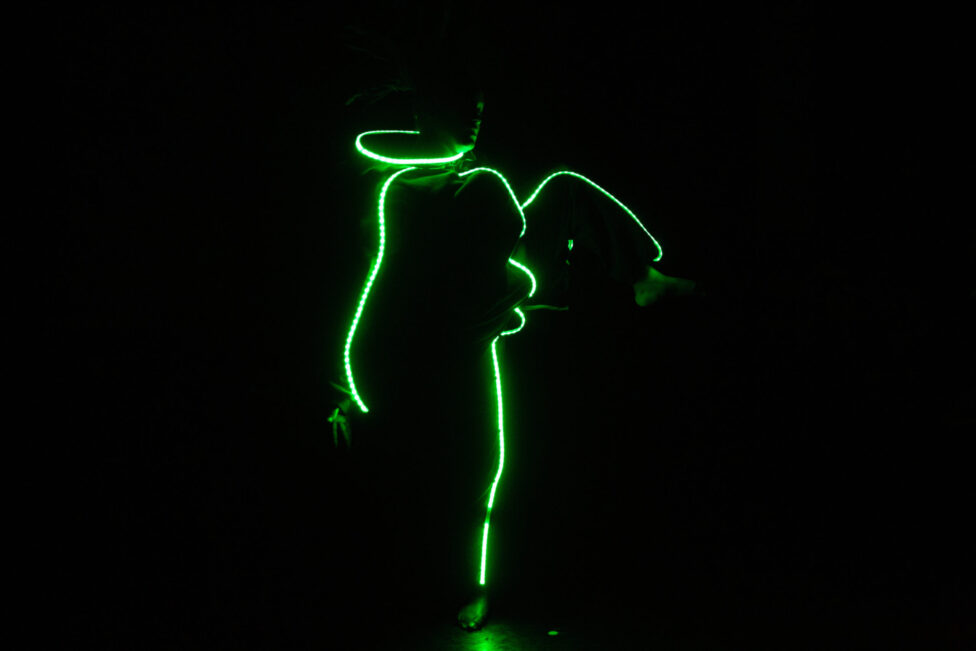Alice Sheppard: (laughter) Rage, rage, rage! So a question that really tipped me over the edge was this question about access for an individual. And I’m like, screw that. When we get into these kinds of places, we then start this kind of detrimental thinking: calculating the cost for an ASL interpreter and a CART person, only for one person in the audience then that person doesn’t show up for the performance. “And we paid all that money!!!”
No, no. This is entirely the wrong thinking about access. It sets up this notion of the individual as a burden. It gives institutions a way out through access. It reinforces access as the idea of this retroactive accommodation. It sets up this notion that you didn’t apply for access two weeks out, so sorry, we can’t do access.
And it continues to make sure that access is something that is added on, if one of those people shows up. What if the event was accessible from the beginning in the first place? Whoever is thinking in that kind of individualist framework is like 20 years ago in the conversation. No, I’m sorry. I don’t have time for that. We moved on. There are other approaches to thinking through the work.
Londs Reuter: I wonder if that might be a useful way for us to tip into this conversation. How you’re thinking about access, how that pushes against individualism.
AS: Right? So commissioning and presenting venues, galleries and artists need to start the conversation at the point of view of creation. So captions on Zoom are prepared, not because they know that there’s going to be a D/deaf, Hard of Hearing person on the phone, but because it is routine: the captions and access are just there.
Multiple people in performance environments need multiple inputs. And so there’s a kind of diagnostic deficit if you wait until a disabled person shows up and says they need a specific kind of access relative to a specific impairment. What if you start actually reformulating all of your procedures and ways of working to be accessible? Down to how you talk about breaks or the daily practices of the organization.
What if you captioned your images, your logo was accessible, you automatically made transcripts and had audio visual verbal descriptions, and you actually did accessible practices in email communication. Then, you make contact with commissioned artists. You talk about access in the work. Access is NOT a dingy thing you do after the fact for those disabled people. What if it had a place in artists’ creative practice?
LR: Are you proposing access as a shared venture between both a presenting organization and an artist? I’m curious about the cooperation in that moment, especially as an artist who’s an access worker. I see the potential friction between those two entities, which can arrive at those conversations with totally different motives and education about this.
AS: I’m not proposing that.
LR: Okay.
AS: I think back to one moment, at the Whitney, after a Kinetic Light show in the Q&A and this has been a relatively accessible performance so there was ASL, audio description, and the show was about ramps for ADA day. Walei Sabry asks, “Whose responsibility is access? Is it the artists’ or the venues responsibility?” The obvious answer is it’s everyone’s responsibility. The work is how this happens. Just because I’m imagining a partnership does not mean that the costs get pushed off on the artist.
LR: Yes!
AS: Venue, presenter, galleries, producer, whatever.
LR: Right.
AS: Do not push the costs off on the artist.

Kayla Hamilton: I personally have had the experience where an organization requested accessibility practices but then they waited until the very end saying, “Oh no, we’re not going to do that.” So, my work was accessible, but everybody else’s was not. And they expected me to cover the cost of making the entire show accessible versus covering the costs themselves.
LR: Yeah. I’ve had a similar experience of participating on a shared bill in a performance where I have embedded access practices in my work, but the other performances that evening have not. It sends a message. It shows a really disproportionate way that labor is getting absorbed. Who’s doing that work and who isn’t. I’ve been in that situation more than once. And yes, I cover that expense.
AS: I don’t want to be having access battles with people, you know?
LR: No.
AS: I recognize as a disabled artist, that even when I do the best I can, access needs are growing and changing. And what we’re learning about it is growing and changing,
LR: Are there practices you have learned or relearned or embedded into your work in different ways? Because I think there’s also a notion and fear that people have of doing it wrong. When really, there’s no singular way to make something accessible. There’s a multitude of ways, and sometimes they’re even in conflict. These things can and should be negotiated!
KH: I’m trying to make the work that is accessible to blind and low vision people. I want to disrupt the notion that dance can only be consumed via the eyes. In the beginning, unfortunately I use eyepatches to simulate a disability in order to force my audience to ‘see’ differently. At the time, I was completely unaware of the harm that would do to my community. So now my current practice is using language as choreography. So there is a play between physical music and the descriptions of the movement. Alice has pushed and challenged me to think about the ways I can bring my full self in my artistic practice instead of just ignoring the parts of myself that I’ve been conditioned not to like and erasing them from the process. Some of the questions I’m always interrogating through my process are considering how descriptions are being delivered. Who is delivering the description. Can sound be description and movement? And how can I get sighted people to see differently.
AS: Hell, Yes!
KH: So I’m always in a state of constant learning. Sorry, I feel like I’m getting emotional. Because I’m toying with my own identity and what I can bring to make the art that I want to see in the world. But at its core, my work is about playing with descriptions as a generative practice. So it’s the beginning, the middle, and the end. For my community, my specific community, and I’m sure other practices will come into the fold in addition to descriptions,, but this is what I feel like I need right. Because then that’s when you fuck some shit up. Stick with what you know. Right.
(Laughter)
Go with what you know, you know what I mean? People are like, I wanna do this and this and this. That’s great. But I’m about solid five years from doing something else.

LR: But I love it cause you’re tracking not just the evolution of where you started with thinking about simulation into where you’re thinking about description, but you’re also thinking about how the timeline allows future space for you to evolve in that practice, which is an exciting notion to me. You’re actually proposing a bigger timeline that also includes how we’re going to keep evolving towards something and that feels…
KH: Yeah. And maybe because it’s so personal because it’s not just art, right? It is art, but it’s bigger than that. I need time for it to be authentic and to be real, to myself and to the people that I’m making art for. And I’m always centering blackness as a part of the conversation. I don’t want to get rid of that.
AS: Something about where you left off Kayla. In the disability justice movements, access and race and art are intimately tied up. But what isn’t very clear yet is how that extends into this world that we’re stuck in. The larger white institutions don’t understand these things as being bound up intimately. So access itself needs exquisite exploration as we look at race. It’s justice led formulated by disabled, queer, trans, BIPOC folk. But you go to the theater and most often the leadership is white. So you’ve got this gap where there’s a complexity around access, which is often racially inflected and racially informed. I don’t know what we make of that because access is different. Like access practices are different. And this way it’s done, person to person versus institution to person can often fall along racialized lines. So that…
LR: Yes.
AS: [Alice swings arm in the air] There’s an arm again.
LR: Hello!
AS: That’s clearly the gesture. I hope.
KH: We have to get this arm into whatever is being transcribed
(laughter)
LR: It’ll go on the transcript.
KH: Yeah, definitely.
(laughter)
LR: Maybe, I can state the obvious that I’m the white person on our call and I am currently affiliated with a large institution, which is a really confusing space for me to find myself in and relatively new at that. Kayla and I were talking about this before you got on the call, Alice, but I’m in a relationship with an institution that I’ve never had before, where I’m not just passing through. I’m not just a freelancer coming through or a part-timer. I’m um…
KH: You’re there!
LR: I’m in the beast. So that means I am the beast. I wonder if there are things you want to ask me or if there are ways I can step back from this so that you can have that dialogue, I don’t know. I’m offering my position and malleability in this conversation. I want to name my whiteness and my work and to offer that I can be here for the accountability. I’m here for it.

KH: For me, this conversation is centering on disability. However, I want to make sure that when I’m in conversation about disability, that I mention intersectionality because I don’t always often hear it inserted. Period.
AS: It’s essential. It’s who I am. It’s what I am. It’s where the work is. The perception of disability can overwhelm complex questions of race. So I talk about them all together because they come together.
So it’s critical that we not just talk about access, but also about how access is handled. In a well-resourced institution, you might have equipment to hand. Whereas in the smaller community you might have what Michelle Mantione calls “consensual access,” where access is provided specifically by one community member to another community member. So consensual individual access is actually some of the ways in which to say when people want interdependence.
LR: I’ve never heard this language before and I feel really grateful for it. “Consensual access.” And actually, it’s been a real entry point for me as a non-disabled person into understanding accessibility, into considering disability justice. I was in negotiations with a disabled person, a collaborator. We had to create the conditions that would allow us to work. We had to create schedules that had consensus and agreements were bound up in care. It was a real entry into access work for me as a non-disabled person, so I’m grateful for that term.
KH: You know, the more I’m learning about disability justice and the history of disability in this country, through what I’ve been reading, has been forged by people of color. And it’s very exciting to me. It’s allowing me to step into something and I’m curious to know more and bring other disabled people of color into the conversation, in terms of artistry. I need to find them. Not necessarily just artists, but scholars, writers, and theorists too.
AS: For the moment, the dance world is pushing some edges. Maybe it has to do with some of the work that Dance NYC did way back. The dance world is like crushing it. But I have a question for you, Kayla, if I may..
KH: Yeah!
AS: You said earlier you’re making the work that you want to, that’s personal, that you want to be in the world for you. And I’m trying to imagine the world we keep creating. Where do you see your work going? And I’m curious in hearing you talk, because we talk process all the time, about product or performance or experience or how you imagine people understanding, feeling grasping, and encountering your work?
KH: At this moment, using descriptions gives you other ways of beginning and entering the work. So if the movement isn’t necessarily speaking to you, maybe the language is. This gives access to the audience to enter into my work in multiple ways while allowing them to access their own personal agency in how they experience the dance. The more choices you have the less it becomes about being “this is good” or “this is bad.” It becomes more about what you can relate to and learn from.
LR: Right now we’re inventing ways of being together virtually that are new and old at the same time. People are catching our form in ways that we don’t understand yet. Liveness and togetherness is so much the bedrock of dancing and I don’t know how we forge ahead without it or adapt it for this way that we are now. We can’t know yet. This is going to take time.
Alice: Yeah. Yeah. It’s unreal…AHHH!
LR: Thank you to both of you for being up for the conversation, for diving in, for bringing your rage.
AS: Sorry. I feel like I just sort of kicked it off with this whole kind of like…RAHHH!
KH: It was iterative. It was good.
LR: And honestly, when I was approached to be in dialogue about access, it felt super important to me that I shared the mic on this and that’s not a symbolic gesture. That’s also because there’s experiential knowledge that you both have to share that I don’t. And you bring something that I wouldn’t have brought. So, I’m grateful that you brought yourself and you were willing to do it with me.
AS: Part of what I do is not to imagine access, but to imagine a disabled audience, which is a separate question. I imagine the aesthetic of access. If you imagine a disabled audience you have a separate kind of questioning. And Kayla, I see and hear that in your work. You are imagining work through a blind appearance. So access is part of the creative aesthetic of the work. In the creative process, we imagine who’s in the room. We imagine the audience. And if we imagine a disabled audience that deeply informs the creative pathway and practice of the work. If you imagined the disabled audience, and this is something I think Michael from Kinetic Light does really well; He is imagining how people experience a performance relative to their place in the theater..
People don’t even get to choose where they sit because the theater has those accessible seats in the crappiest sight lines. Michael’s imagining sight lines that prioritize the perspectives of disabled people. What that would mean to actually have sound that prioritizes Deaf experience? These questions are a very different set of questions than is this work accessible?
LR: Oh yeah. And of course, accessibility is in no way a monolith and disability is incredibly diverse. Imagining a disabled audience allows for that breadth and multiplicity of so many different types of experiences that might show up in your audience.
AS: And in your work.
LR: Yes. And your patrons and your ticket buyers. If that shifted, everything would ripple out.
AS: Some incredible work would be made. That would be fun.
LR: Mmm.
AS: You know. Laurel Lawson often says something like, “A quarter of the population is disabled. You can make a choice about that and say, ‘I don’t care that 25% of the people will never encounter my work because I didn’t make it accessible.’ And you can make that choice, but it says a lot if you do.”
LR: I hope you keep making this work and that more people take up this charge. And I hope you keep doing the things that make you feel safe and alive. This conversation helps me keep the art alive in this moment when it feels fragile.
KH: Thanks Londs for bringing disabled voices into the conversation. Because from what I understand, the invitation was directed at you but you said, “Wait, hold up.” I have much respect for what you did. Not everyone would do that.
LR: This is not the first time we’ve been in that dynamic too.
KH: Yeah. No, no.
AS: I look forward to the future shape of this conversation. I’m so happy that we had it.
Image information:
Photos 1 and 3: Balancing on one foot with right fingers extending to the ground and left leg lifted up at an angle, Kayla Hamilton’s body is barely seen in the dark. Her shape is vaguely lit up by the small tubes of neon green light attached to her ankles, tracing up her thighs, her upper body, hugging the hood around her neck, and running down her arms. Photo by Scott Shaw
Image 2: Alice Sheppard tips forward on the wheelchair, yet her body is suspended in an upright position. Her eyes are closed, her face is relaxed, her arms holding two clutches are reaching up for the sky as if surrendering to gravity. Photo by Mengwen Sao
Image 4: A white person, Londs, in a dance studio lifts her elbows while another person, Dan, sits on a stool and watches. Between them in the foreground is white poster board propped up on a short, metallic easel. Photo by Cortney Andrews





